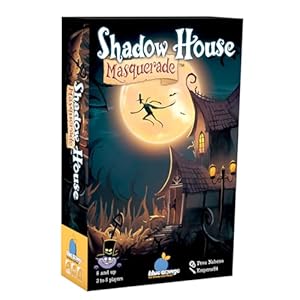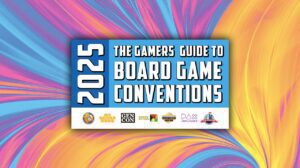Horrified: Dungeons & Dragons – Andy Matthews
We’ve written extensively about the Horrified franchise, covering the original game, American Monsters, Greek Monsters, and World of Monsters. With each release Ravensburger extends their reach into new territory. But with Horrified: Dungeons & Dragons, they’re going pure fantasy and doing their best to cater to multiple fanbases.
In this newest entry players take on the iconic roles made famous in Dungeons & Dragons: fighter, cleric, rogue, wizard, etc., and fight against classic monsters like the Red Dragon, Displacer Beast, Mimic, and the Beholder. The gameplay is largely the same, with just a few exceptions; there are teleport spaces which allow you (and monsters) the ability to more easily jump around the map, a 20 sided die used by players in their special abilities, and others.
The only downside is the box only comes with 4 monsters, which is leaving many fans scratching their heads. The other games come with more, and there are so many great monsters to choose from. How could they leave out the Owlbear, or a horde of Kobolds, Lichs, or Gelatinous Cubes?! But regardless, if you love the Horrified franchise, and/or are really interested in D&D, then this is a no-brainer for you. Use it as a quick intro to a night of role playing, or a way to wind down after a long campaign.
Ease of entry?
★★★★★ – No sweat
Would I play it again?
★★★★☆ – Would like to play it again
Read more articles from Andy Matthews.
Caesar & Cleopatra – Andrew Lynch
My first game of Caesar & Cleopatra left me with one question: “Why isn’t this great?” The two-player card game from designer Wolfgang Lüdtke, originally published in 1997 and now brought back to print by KOSMOS, checks nearly every box on my list of things that make a game great: Limited turns that accumulate in interesting ways, high interactivity, plenty of information without anything approaching perfect information, the ability for players to alter the tempo, room for bluffing and personal expression, and just a dash of luck to keep things spicy. Even so, play after play, it never quite sings.
I don’t know why. I spend a lot of time thinking about this, about what separates a mechanically sound design from something that transcends. Why is Lost Cities incredible, while Caesar & Cleopatra barely registers more than a shrug? I couldn’t tell you. I’d love to know.
Ease of entry?
★★★★★ – No sweat
Would I play it again?
★★★☆☆ – Wouldn’t suggest it, but would happily play it
Read more articles from Andrew Lynch.
Prêt-à-Porter – Bob Pazehoski, Jr.
The genius of Prêt-à-Porter boils down to a ratio— nine action areas, but only three action markers per round. To make matters tighter, the action areas are limited, occasionally leaving players out in the cold. This economic title set in the fashion world presents a tight ship full of meaningful decisions and a hint of punishment for wasted time or undue foolishness. I like it.
Prêt-à-Porter is fifteen years young now, but the design holds up. I appreciated that I was able to sit down with a loose familiarity, walk through the rules, and feel confident to engage. I made one mistake before the first of the game’s four exhibition rounds and it definitely held long-term consequences for the rudimentary strategic path I was chasing, but it never got in the way of my enjoyment. In fact, the mistake helped me grasp the big picture and drew me into the thematic goodness— I knew what I was about from that point forward and several bits fell into place. As we rolled into our final exhibition round, I was struck by the fact that everyone had built a very different engine and placed their eggs in a variety of baskets. I was on pins and needles to see which approach paid off.
In short, Prêt-à-Porter is a winner. The fashion theme definitely meshes with the economic environment to create a diverse, thoughtful, and crunchy good time.
Ease of entry?
★★★★☆ – The odd bump or two
Would I play it again?
★★★★★ – Will definitely play it again
Read more articles from Bob Pazehoski, Jr..
Shadow House: Masquerade – Justin Bell
Blue-Orange Games (the publishers of many fantastic family-weight games, such as the Kingdomino series) sent a review copy of Shadow House: Masquerade, so I wanted to get it to the table with a larger group. I tried to wait long enough to get a full group of eight players (the game’s max count), but in light of it being summer in Chicago—a time period when dreams of large game nights go to die—I settled for five. I’m not sure it really mattered, because in the words of one player, Shadow House: Masquerade is the rare combination of being “deeply random and deeply complex.”
At its core, Shadow House: Masquerade is a hidden role game based on the Japanese deduction game Hannin Wa Oduru (2013), designed by Pesu Nabenu. Players are dealt a small hand of cards and are tasked with finding out who is the culprit along with any accomplices who are responsible for a dastardly crime set at an aristocrat’s dinner party. In each round, one player is the culprit, and others need to identify the owner of the culprit card using card powers or the straight-up ability of a detective or a “tory” to just call out who they think the culprit is. Points are awarded to the good guys if they ID the culprit before the culprit reveals themself on the final turn of a round, with the reverse being true if the culprit survives the round.
There’s a little more to it than that, but not much. As one would expect, it’s not a bad idea for the detective or the tory to just guess and name a player who they think is the culprit. That’s what happened in our game, but that was after a teach that included detailing the four separate win conditions (!!!) and reminding players that essentially all of the character powers are just spelled out on each card. For fans of exercises like Bang! or the games of that family, or better and faster games like Coup, Shadow House: Masquerade might be worth a look…but this is generally a category of games that is Not For Me.
Ease of entry?
★★★☆☆ – There were a few questions
Would I play it again?
★★☆☆☆ – Would play again but would rather play something else
Read more articles from Justin Bell.
Emberleaf – Kevin Brantley
I had never heard of Emberleaf, and with the gaming world’s tendency to swarm to a new hot game every other week, I caught wind of the heat. Luckily, I have a friend in my gaming group who’s the silent partner type and backs a bunch of Kickstarters. He usually doesn’t announce what he’s backed until it shows up at his door. Sure enough, Emberleaf was one of those drop-shipped games, and I had a chance to check it out.
As I watched the teach videos, I thought, This doesn’t seem that interesting. I was quickly humbled within the first couple of turns. Emberleaf is this odd smorgasbord of “card-dancing,” area control, contract fulfillment, engine-building, resource management—and probably a few other things too. Yet it works SO well.
This game blew me away and yet I had never heard anything about it. The card synergy is incredible if you can time it correctly, and I imagine you’d never play the same game twice. The art and production are outstanding, reminiscent of Kyle Ferrin’s work on Root. Oftentimes when a game tries to juggle too many systems, it falls apart, but everything in Emberleaf just clicks. It creates this ecosystem where you need to do a little bit of everything to succeed.
I glanced at the deck, and we only saw about 20% of the possible contract deck and maybe 40% of the draftable critter cards, so there’s a ton of variety to encourage repeat plays. There are even two big, red, thick sealed envelopes that say Do not open under any circumstance. When do I open these? I need to know! What’s inside??
Ease of entry?
★★★★☆ – The odd bump or two
Would I play it again?
★★★★★ – Will definitely play it again
Read more articles from Kevin Brantley.














Add Comment